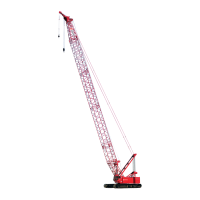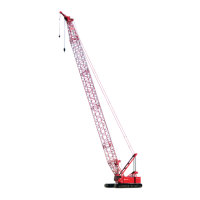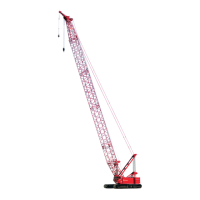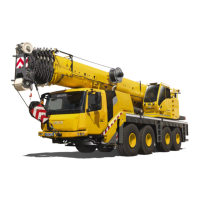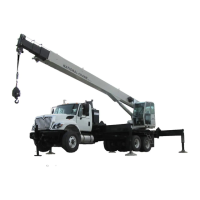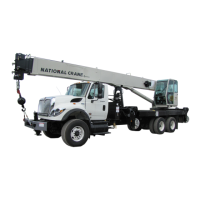Manitowoc Published 05-09-17, Control # 014-28 5-15
16000 SERVICE/MAINTENANCE MANUAL HOISTS
3. For steel sheaves, check depth, width, and contour of
each sheave using a groove gauge as shown in
Figure 5-12
. Replace sheaves that have over or under
size grooves.
4. Replace grooved drums that allow one wrap of wire rope
to contact next wrap as rope spools onto drum.
5. Inspect sheaves to verify they do not contact another
sheave or structural plate work. There should be uniform
clearance between sheaves in a cluster. Repair or
replace worn or damaged sheaves.
6. Remachine or replace steel sheaves, drums, or rollers
that have been corrugated by the wire rope’s print as
shown in Figure 5-13
.
NOTE: Depending on the type of wire rope used, It is
normal for nylon sheaves to show the wire rope
print. Do not remachine nylon sheaves.
7. Inspect nylon sheaves for excessive tread diameter
wear at locations E in Figure 5-11
. Measure at three
positions to check for uneven wear.
Wear must not exceed the limits given in the table.
Replace worn or damaged sheaves.
NOTE: Nylon sheaves cannot be accurately inspected
using conventional methods such as sheave
gauges.
Due to the characteristics of nylon sheaves, the
nylon material will actually move to better support
the wire rope as the sheave wears normally.
Nylon sheave properties will be degraded in
temperatures above 140° F (60° C).
8. Inspect nylon sheaves to verify they have not separated
and “walked off” steel inserts or bearings as shown in
Figure 5-14
. Maximum sideways displacement is 1/8 in
(3 mm). Replace worn or damaged sheaves.
9. Make sure sheaves, drums, and rollers are properly
lubricated according to the instructions in the lubrication
guide provided with the crane (see Section 9).
Many current production sheaves are not equipped with
grease fittings, but are packed with grease at assembly.
Repack the bearings of these sheaves with CraneLUBE
EP #2 grease when the sheaves are overhauled.
Due to application and design variations, it is not
possible to give specific grease repacking intervals or
the life expectancy of components.
NOTE: For some sheaves, the seals are an integral part of
the bearing. Therefore, if a seal is damaged during
repacking, the complete bearing may have to be
replaced.
LOAD BLOCK AND HOOK-AND-WEIGHT
BALL INSPECTION
The operating condition of the load block and the hook-and-
weight ball can change daily with use; therefore, they must
be inspected daily (at start of each shift) and observed during
operation for any defects which could affect their safe
operation. Correct all defects before using the load block or
the hook-and-weight ball.
WARNING
Falling Load Hazard!
To prevent load from dropping due to structural failure of
load block or hook-and-weight ball:
• Only use a load block or a hook-and-weight ball
which has a capacity equal to or greater than load to
be handled.
• Do not remove or deface nameplate (Figure 5-15
)
attached to load blocks and hook-and-weight balls.
• See Duplex Hook topic in Section 4 of Operator
Manual for recommended sling angles and capacity
restrictions when load block has duplex or
quadruplex hook.
FIGURE 5-15
1
2
3
4
5
6
Item Description
1 Working Load Limit (ton (US and metric)
2 Wire Rope Diameter (in and mm)
3 Block Weight (lb and kg)
4 Block Serial Number
5 Block Part Number (OEM and Manitowoc)
6 Design Factor
